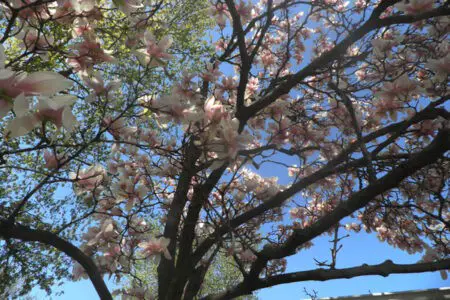Generally, the seed-producing plants are known as an angiosperm. The word “angiosperm” is derived from the two Greek words, ‘angeion’ meaning case and ‘sperma’ meaning seed. This type of plant produces fruits within which lies the seed or seeds. They can grow in different types of habitats. Based on habitats, they have various names such as hydrophytes (in water) mesophytes (in moist soils), xerophytes (in xeric conditions), halophytes (in saline soil) and epiphytes when they grow on other places. Aquatic and terrestrial angiosperms are worldwide in distribution. Angiosperms may be herbs, bushes, shrubs or trees, and small flowering plants.
Salient Characteristic Features of Angiosperms
- Angiosperms can grow as trees, shrubs, bushes, herbs, and small flowering plants.
- They produce flowers during their life. Flowers act as reproductive organs and transmit genetic information in the next generation by producing small pollen grains.
- They produce endosperm after fertilization and serves as a nutritional food source for the developing seed and seedling.
- Angiosperms have diploid sporophytes (2n) and have characteristic underground root, and aerial shoot system.
- Angiosperms have normal or tap roots or adventitious with branched or un-branched stems.
- They have very complex root system which contains cortex, phloem, xylem, and epidermis.
- Roots bear hair-like structure which helps to absorb water minerals from the soil. In this case, absorption occurs by active transport and diffusion.
- The herbaceous plants may be ephemerals, annuals, biennials or perennials.
- The leaves are diverse and are of five principal types: seed leaves, scale leaves (cataphylls), foliage leaves, floral leaves, and bract leaves.
- The leaves play an important role to carry out photosynthesis and are covered by a waxy cuticle to prevent water evaporation from leaves.
- In the upper epidermis of the leaves, stomatal openings are absent which aids to prevent excess transpiration.
- Leaves may be simple or compound. In this case, leaflets are present in compound leaves. Generally, the normal flattened, expanded green leaves are known as foliage leaves. The foliage leaves may be stipulate or ex-stipulate. The leaf blade or lamina may be dorsiventral or isobilateral.
- Angiosperms contain well-developed conducting tissues such as the xylem and the phloem which forms vascular bundles. In this case, xylem bears vessels while phloem contains sieve tubes and companion cells.
- The vascular bundles are radial in roots. In this case, xylem and phloem are arranged alternately and are exarch
- In the stem, the vascular bundles are conjoint collateral open (cambium present) or closed (cambium absent) or bi-collateral and are endarch.
- The xylem elements are trachaea or vessels, tracheid, xylem parenchyma, and wood fibers.
- Flowers may be solitary or occur in groups forming inflorescence. The inflorescence may be racemose or cymose or mixed type.
- Flowers may be complete or incomplete, unisexual or bisexual, regular or irregular, actinomorphic or zygomorphic, sterile or naked, hypogynous or epigynous or perigynous.
- The flowers bear short-axis thalamus where the four whorls of sporophylls are arranged. The four floral parts are calyx, corolla, androecium, and gynoecium. The whorls are made by petals, sepals, carpels, and stamens.
- Calyx and corolla are the accessory floral parts while the sepals are green and the petals are colored.
- The stamens and carpels are the essential whorls of flowers which help in reproduction. In this case, stamens produce the pollen grains with the male genetic information while carpels are enclosed by developing seeds and turn into a fruit.
- Each stamen (male organ) is composed of a slender stalk, the filament and a sac-like anther which produces pollen grains.
- Each carpel (female organ) is composed of ovary (swollen basal portion), style (slender stalk) and stigma (the tip of the style).
- The ovary contains certain bodies, the ovules (megasporangia).
- The pollen grains are transferred from the anther to the tip of the stigma through pollination.
- Before fertilization, the development of the male gametophyte is completed within the pollen tube. Pollen grain (microspore) on germination produces the male gametophytic plant and megaspore on germination produces the female gametophytic plant. Both types of gametophytic plants are dependent upon the sporophytic plants.
- In angiosperms, fertilization occurs by the insect or wind pollination.
- After fertilization, the endosperm is produced which helps to provide nutrition to the developing embryo and the seedlings. Seeds are produced from the fertilized ovule that turns into a fruit. In this case, seeds are encircled by fruits.
- . In the female gametophytic plants of angiosperms, female sex organs like archegonia are not formed while the male gametes are always non-flagellate and non-motile.
- Double fertilization takes place during which endosperm is produced, which is triploid (3n).
- Seeds are formed and lies within the fruit. Fruits and seeds are formed from the ovary and ovules respectively.
- Seeds possess one (monocotyledons) or two cotyledons (dicotyledons) and may be albuminous (endospermic) or exalbuminous (non-endospermic).
- Germination of seeds may be hypogeal or epigeal. Sometimes viviparous germination noted in the plants growing in the saline mixed soil.
- The fruits are either simple, aggregate or multiple. The simple fruits may be dry or fleshy.

Parts of Flowers of Angiospermic Plants
Concluding Remarks
Angiosperm forms the largest and diverse group of the kingdom Plantae which contains about 300000 species under 64 orders with 416 families.The angiosperm is also known as flowering plants, Angiospermae or Magnoliophyta. About 80% of known living green plants belong to Angiosperm. Majority of all plant foods that we eat come from angiosperm. Among them, the notable are fruits, grains, vegetables, most nuts or beans.
You might also read: Gymnosperms: Salient Characteristic Features

